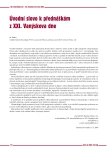Thrombocytopenic purpuras
Authors:
P. Salaj
Authors‘ workplace:
Ústav hematologie a krevní transfuze, Praha, ředitel prof. MUDr. Pavel Klener, DrSc.
Published in:
Vnitř Lék 2005; 91(7 a 8): 854-860
Category:
128th Internal Medicine Day - 21rd Vanysek's Day Brno 2005
Overview
Thrombocytopenic purpura represents a heterogeneous group of diseases which is characterized by bleeding tendency and a low number of platelets. In general, the risk of bleeding increases with a decreased number of platelets. However, the patient prognosis depends more on the type and cause of disease than on platelet numbers. The detailed differential diagnosis of thrombocytopenia is very important because the reduced number of platelets is only one of the symptoms associated with other diseases. Pathophysiological etiology of thrombocytopenias is characterized by low platelet production, higher platelet destruction in blood stream or sequestration of platelet in reticulo-endothelial system. Consumptive non-autoimmune thrombocytopenias are the most risky from the group of thrombocytopenic purpura. They represent high risk of a severe bleeding and consumptive microangiopathy connected with organ ischemia.
Key words:
thrombocytopenic purpura – bleeding – platelets - consumptive microangiopathy
Sources
1. Alving BM. How I treat heparin-Induced thrombocytopenia and thrombosis. Blood 2003; 101: 31-37.
2. Ben-Yehuda D, Gillis S, Eldor A. Clinical and therapeutic experience in 712 Israeli patients with idiopathic thrombocytopenic purpura. Israeli ITP Study Group. Acta Haematol 1994; 91: 1-6.
3. Berchtold P, Wenger M. Autoantibodies against platelet glycoproteins in autoimmune thrombocytopenic purpura: Their clinical significance and response to treatment. Blood 1993; 81: 1246-1250.
4. Colman RW, Hirsh J, Marder VJ et al. Hemostasis and Thrombosis. 4th Ed. Philadelphia: William and Wilkins 2001.
5. Furlan M, Robles R, Solenthaler M et al. Deficient activity of von Willebrand factor-cleaving protease in chronic relapsing thrombotic thrombocytopenic purpura. Blood 1997; 89: 3097-3103.
6. Furlan M, Robles R, Solenthaler M et al. Acquired deficiency of von Willebrand factor-cleaving protease in a patient with thrombotic thrombocytopenic purpura. Blood 1998; 91: 2839-2846.
7. George JN at al. Idiopathic Thrombocytopenic Purpura: A Practice Guideline Developed by Explicit Methods for the American Society of Hematology. Blood 1996; 88: 3-40.
8. Nagasawa T, Hasegawa Y, Komeno T et al. Simultaneous measurements of megakaryocyte-associated IgG (MAIgG) and platelet-associated IgG (PAIgG) in chronic idiopathic thrombocytopenic purpura. Eur J Haematol 1995; 54: 314-320.
9. Rock GA. Review: Managemant of thrombotic thrombocytopenic purpura. B J Haem 2000; 109: 496-507.
10. Stasi R, Stipa E, Masi M et al. Long-term observation of 208 adults with chronic idiopathic thrombocytopenic purpura. Am J Med 1995; 98: 436-442.
11. Tsai HM, Lian EC. Antibodies to von Willebrand factor-cleaving protease in acute thrombotic thrombocytopenic purpura. N Engl J Med 1998; 339: 1585-1594.
Labels
Diabetology Endocrinology Internal medicineArticle was published in
Internal Medicine

2005 Issue 7 a 8
Most read in this issue
- Post transfusion reactions
- Thrombocytosis and thrombocythemia
- Antiphospholipid syndrome – diagnosis and treatment
- Anemia of chronic disease
